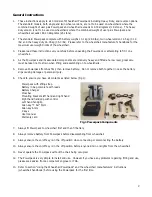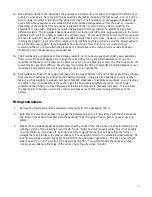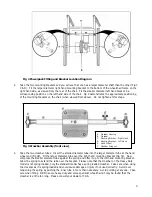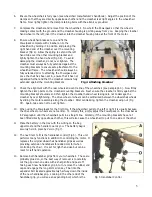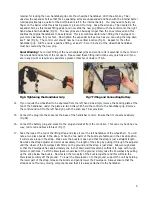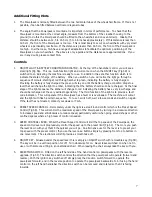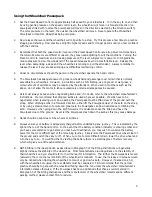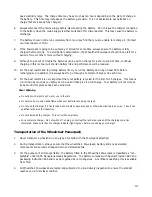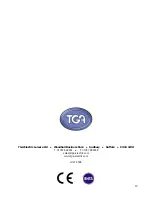
10.
The standard Wheelchair Powerpack is not to be used on wheelchairs where the weight of the occupant
and chair exceeds 114.30 kilograms (18 stone). The heavy duty Wheelchair Powerpack is not to be used
on wheelchairs where the weight of the occupant and chair weight exceeds 165.10 kilograms (26 stone).
11.
It is important to check all the Powerpack bolts and fittings for tightness paying particular attention to the
crossbar fixings and the handlebar grips, also battery terminals. This should be done initially after the first
journey, then regularly at monthly intervals. Pay particular attention to the crossbar wing nut (fig. 3f) after
the initial journey and check regularly to ensure it remains tight and that the Powerpack is centrally
located. This is very relevant if you have a Twin Wheel Powerpack model where the greater forces
involved (plus increased power and occupant weight with the Heavy Duty model) can apply additional
strain on this fixing. All Twin Wheel models are fitted with two wing nuts for additional security and both
should be checked regularly to ensure they are tight at all times.
Batteries
1.
The Wheelchair Powerpack has adequate range and power for its intended use. However to keep it
working to its maximum potential means that its battery must be maintained properly. Correct charging
will maximize battery life and ensure the Powerpack is always ready to go when you are. Following these
instructions correctly will ensure you get the best results from your battery.
2.
The battery fitted is the latest in battery technology. It is sealed and maintenance free and especially
designed for powered mobility. No topping up is required. It can be stood in any position, on its side or
upside down, there will be no leaks.
3.
As the batteries are sealed they are acceptable for air travel. Please consult your carrier prior to departure.
NB Each carrier reserves the right to carry what may be termed as hazardous cargo. TGA cannot be
responsible for their final decision.
Battery Charging
1.
Always use the charger supplied with the Wheelchair Powerpack. It is designed for use with the battery
supplied and any other charger may be dangerous to use or cause damage to the battery. In addition,
alternative chargers will not correctly charge the battery and will void the warranty. The new charger has
automatic input voltage selection between 100 & 240v AC and can therefore be used in any country of the
world (with the appropriate plug/socket adaptor).
2.
The charger supplied is of the very latest technology and fully automatic. It has a two colour indicator light
on the front panel, showing red when the battery is charging and green when fully charged.
3.
To charge, disconnect the plug and socket between the battery and the Powerpack (Fig 7) and connect the
charger to the battery. To ensure correct connection this can only be done one way, red to red and black
to black.
4.
Connect the battery charger to the mains supply and switch on. The indicator light will illuminate green to
show a correct connection has been made. At this point the charger will seek to determine whether the
battery is fully charged or in need of charging. After a few minutes the light will either change to red to
indicate the battery is in need of charging or if it stays green the battery is fully charged and the charger
can be disconnected.
5.
When the battery is fully charged the indicator light will change from red to green. At this point the
charger stops charging the battery. The battery cannot be overcharged and the charger can either be
disconnected completely or left plugged in and switched on until the Powerpack is required for further use.
However we would suggest not to leave on indefinitely. We recommend an overnight charge as this will
provide adequate time for your battery to receive a complete charge and will take advantage of any off-
9


